Macroeconomics Assignment 1: Dollar Value, Interest Rates, and More
VerifiedAdded on 2022/11/13
|11
|2512
|349
Homework Assignment
AI Summary
This macroeconomics assignment delves into several key economic concepts. It begins by examining the factors that cause a dollar to lose its value, including exchange rates, money supply, and purchasing power. It then differentiates between real and nominal interest rates, assessing their relevance. The assignment also explores the distinction between recessions and depressions, outlining characteristics of an economic depression. It covers the concept of marginal propensity to save and applies supply and demand principles to determine equilibrium price and quantity in a market. The assignment also analyzes the impact of international trade and tariffs, including the perspectives of consumers, importers, and producers. Furthermore, it provides an overview of various types of unemployment, such as frictional, cyclical, seasonal, and structural unemployment, and concludes with a discussion of recent trends in the Australian labor market, including participation rates, employment growth, and the influence of the mining sector. The assignment uses relevant economic models and real-world examples to illustrate its points.

MACROECONOMICS ASSIGNMENT 1
MACROECONOMICS ASSIGNMENT
Student Name
Institutional Affiliation
Facilitator
Course
Date
MACROECONOMICS ASSIGNMENT
Student Name
Institutional Affiliation
Facilitator
Course
Date
Paraphrase This Document
Need a fresh take? Get an instant paraphrase of this document with our AI Paraphraser
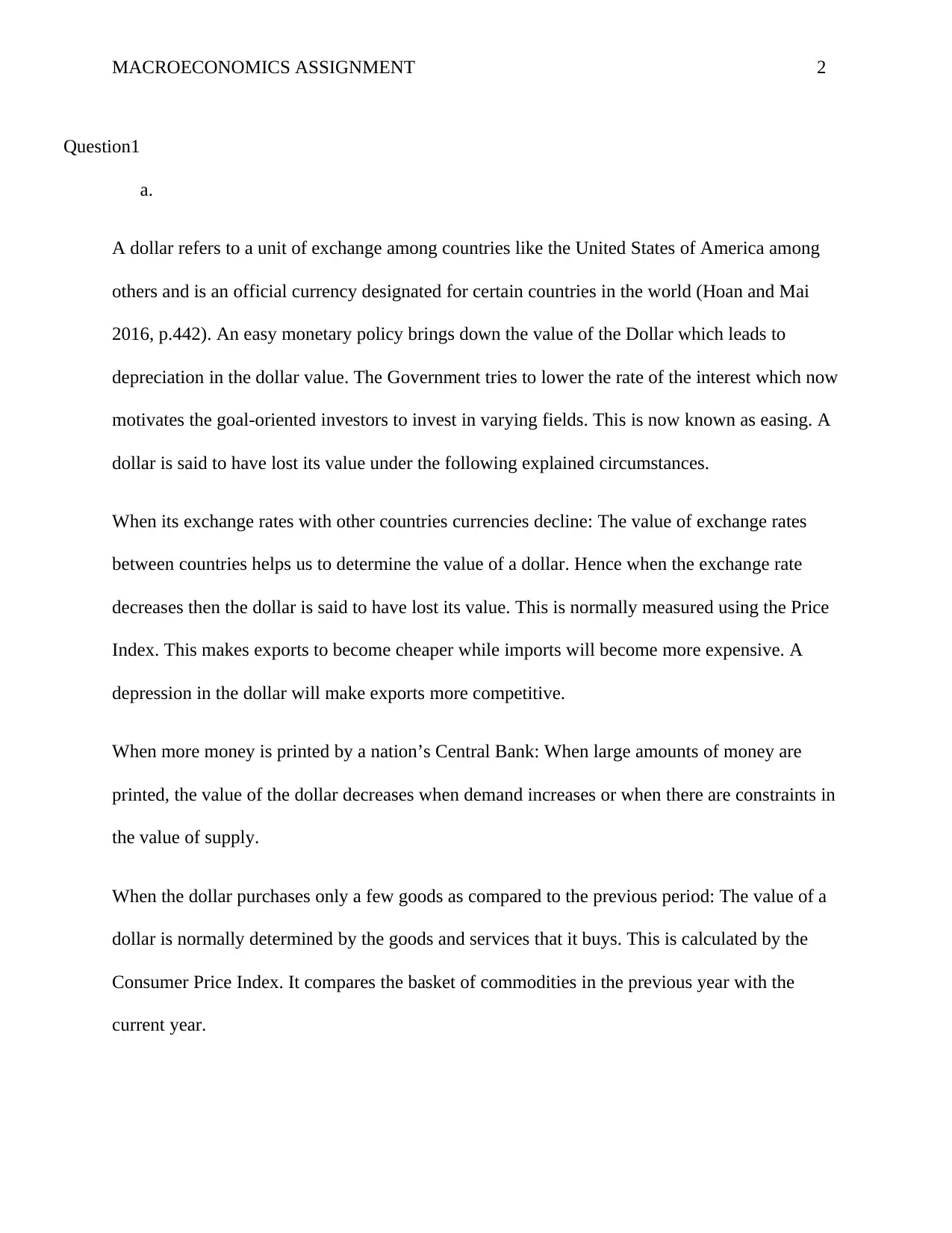
MACROECONOMICS ASSIGNMENT 2
Question1
a.
A dollar refers to a unit of exchange among countries like the United States of America among
others and is an official currency designated for certain countries in the world (Hoan and Mai
2016, p.442). An easy monetary policy brings down the value of the Dollar which leads to
depreciation in the dollar value. The Government tries to lower the rate of the interest which now
motivates the goal-oriented investors to invest in varying fields. This is now known as easing. A
dollar is said to have lost its value under the following explained circumstances.
When its exchange rates with other countries currencies decline: The value of exchange rates
between countries helps us to determine the value of a dollar. Hence when the exchange rate
decreases then the dollar is said to have lost its value. This is normally measured using the Price
Index. This makes exports to become cheaper while imports will become more expensive. A
depression in the dollar will make exports more competitive.
When more money is printed by a nation’s Central Bank: When large amounts of money are
printed, the value of the dollar decreases when demand increases or when there are constraints in
the value of supply.
When the dollar purchases only a few goods as compared to the previous period: The value of a
dollar is normally determined by the goods and services that it buys. This is calculated by the
Consumer Price Index. It compares the basket of commodities in the previous year with the
current year.
Question1
a.
A dollar refers to a unit of exchange among countries like the United States of America among
others and is an official currency designated for certain countries in the world (Hoan and Mai
2016, p.442). An easy monetary policy brings down the value of the Dollar which leads to
depreciation in the dollar value. The Government tries to lower the rate of the interest which now
motivates the goal-oriented investors to invest in varying fields. This is now known as easing. A
dollar is said to have lost its value under the following explained circumstances.
When its exchange rates with other countries currencies decline: The value of exchange rates
between countries helps us to determine the value of a dollar. Hence when the exchange rate
decreases then the dollar is said to have lost its value. This is normally measured using the Price
Index. This makes exports to become cheaper while imports will become more expensive. A
depression in the dollar will make exports more competitive.
When more money is printed by a nation’s Central Bank: When large amounts of money are
printed, the value of the dollar decreases when demand increases or when there are constraints in
the value of supply.
When the dollar purchases only a few goods as compared to the previous period: The value of a
dollar is normally determined by the goods and services that it buys. This is calculated by the
Consumer Price Index. It compares the basket of commodities in the previous year with the
current year.

MACROECONOMICS ASSIGNMENT 3
When fewer transactions are carried with the dollar worldwide: Most transactions in the world
are normally carried out in terms of dollars. This makes it become the World's Currency Reserve.
When its value declines then less trade is likely to occur. This will now lead to lower profits
accrued by the respective countries.
When there is a fall in the country's Treasury: This will make the interest rates to go high. This
will also imply that the Central Bank will hold a little number of dollars hence the demand
declines. The Central Bank uses the dollars to buy the government’s treasuries. This increases
the money supply in the economy and hence lowers the value of the dollar.
b.
A real rate of interest refers to the rate of interest that has been adjusted to remove the
consequences caused by inflation to reflect the total money to the borrower and the real yield to
the lender whereas a nominal rate refers to the stated interest on a loan without taking into
consideration any fees. Real interest rate takes inflation into account. Real interest can be
considered to be predictive when the true rate of inflation is not known. The nominal rate is
considered before taking inflation into account. Low nominal rates normally encourage
consumers to take up more debts and increase their spending. This is what happened in the case
of the Great Recession. The real interest rate is relevant because it can compel the investors to
take more risks in the market. Nominal interests do not really account for inflation which is the
sudden increase in the price of the goods and services. Inflation directly affects the rate of
interest.
When fewer transactions are carried with the dollar worldwide: Most transactions in the world
are normally carried out in terms of dollars. This makes it become the World's Currency Reserve.
When its value declines then less trade is likely to occur. This will now lead to lower profits
accrued by the respective countries.
When there is a fall in the country's Treasury: This will make the interest rates to go high. This
will also imply that the Central Bank will hold a little number of dollars hence the demand
declines. The Central Bank uses the dollars to buy the government’s treasuries. This increases
the money supply in the economy and hence lowers the value of the dollar.
b.
A real rate of interest refers to the rate of interest that has been adjusted to remove the
consequences caused by inflation to reflect the total money to the borrower and the real yield to
the lender whereas a nominal rate refers to the stated interest on a loan without taking into
consideration any fees. Real interest rate takes inflation into account. Real interest can be
considered to be predictive when the true rate of inflation is not known. The nominal rate is
considered before taking inflation into account. Low nominal rates normally encourage
consumers to take up more debts and increase their spending. This is what happened in the case
of the Great Recession. The real interest rate is relevant because it can compel the investors to
take more risks in the market. Nominal interests do not really account for inflation which is the
sudden increase in the price of the goods and services. Inflation directly affects the rate of
interest.
⊘ This is a preview!⊘
Do you want full access?
Subscribe today to unlock all pages.

Trusted by 1+ million students worldwide

MACROECONOMICS ASSIGNMENT 4
Question2
a.
People often say that a recession is when a neighbor loses their jobs and depression as when you
lose your own job (Peersmanand Robays 2012, p.1532). There are several observations that may
make people call an economic downtown a depression. An economic depression is a state where
an economy experiences a great downfall. It is often as a result of a negative activity which is
normally based on the Gross Domestic Product.
The stock market crash: The stock market normally comprises of the stocks and the investors
who literally act as the shareholders. When the market experiences a downfall, the value of the
investments does follow the same path. This declines confidence in the economies.
Control of prices and wages: When wages are controlled by the national government and the
companies then they are not allowed to be lowered. The businesses may be forced to lay them off
for the consumers to survive.
Loss of confidence of the consumers: When consumers are not confident in the economy, then
they can’t really survive. They will have to change their spending techniques and eventually, the
demand will decrease. There could be signals such as the worsening unemployment rate, rising
inflation, the decline of property sales and an increase in the credit cards.
b.
A Great Depression is a decrease in the value of aggregate spending. It lasted for a long period of
time. Let’s say up to 10 years. This was the very worst economic depression of all times. It took
place from October 1929 till 1939 the same year. The main cause of depression is factored to the
Question2
a.
People often say that a recession is when a neighbor loses their jobs and depression as when you
lose your own job (Peersmanand Robays 2012, p.1532). There are several observations that may
make people call an economic downtown a depression. An economic depression is a state where
an economy experiences a great downfall. It is often as a result of a negative activity which is
normally based on the Gross Domestic Product.
The stock market crash: The stock market normally comprises of the stocks and the investors
who literally act as the shareholders. When the market experiences a downfall, the value of the
investments does follow the same path. This declines confidence in the economies.
Control of prices and wages: When wages are controlled by the national government and the
companies then they are not allowed to be lowered. The businesses may be forced to lay them off
for the consumers to survive.
Loss of confidence of the consumers: When consumers are not confident in the economy, then
they can’t really survive. They will have to change their spending techniques and eventually, the
demand will decrease. There could be signals such as the worsening unemployment rate, rising
inflation, the decline of property sales and an increase in the credit cards.
b.
A Great Depression is a decrease in the value of aggregate spending. It lasted for a long period of
time. Let’s say up to 10 years. This was the very worst economic depression of all times. It took
place from October 1929 till 1939 the same year. The main cause of depression is factored to the
Paraphrase This Document
Need a fresh take? Get an instant paraphrase of this document with our AI Paraphraser
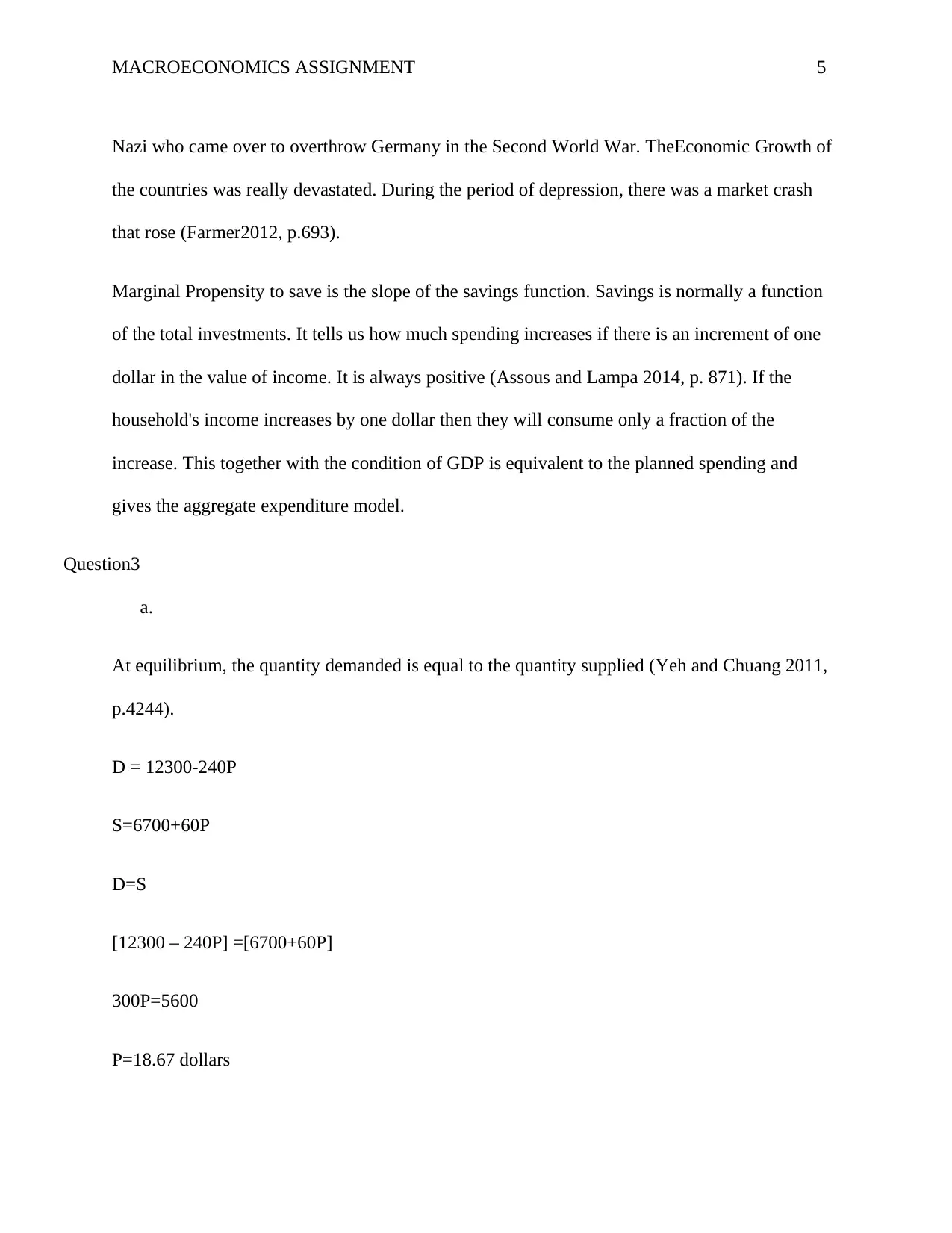
MACROECONOMICS ASSIGNMENT 5
Nazi who came over to overthrow Germany in the Second World War. TheEconomic Growth of
the countries was really devastated. During the period of depression, there was a market crash
that rose (Farmer2012, p.693).
Marginal Propensity to save is the slope of the savings function. Savings is normally a function
of the total investments. It tells us how much spending increases if there is an increment of one
dollar in the value of income. It is always positive (Assous and Lampa 2014, p. 871). If the
household's income increases by one dollar then they will consume only a fraction of the
increase. This together with the condition of GDP is equivalent to the planned spending and
gives the aggregate expenditure model.
Question3
a.
At equilibrium, the quantity demanded is equal to the quantity supplied (Yeh and Chuang 2011,
p.4244).
D = 12300-240P
S=6700+60P
D=S
[12300 – 240P] =[6700+60P]
300P=5600
P=18.67 dollars
Nazi who came over to overthrow Germany in the Second World War. TheEconomic Growth of
the countries was really devastated. During the period of depression, there was a market crash
that rose (Farmer2012, p.693).
Marginal Propensity to save is the slope of the savings function. Savings is normally a function
of the total investments. It tells us how much spending increases if there is an increment of one
dollar in the value of income. It is always positive (Assous and Lampa 2014, p. 871). If the
household's income increases by one dollar then they will consume only a fraction of the
increase. This together with the condition of GDP is equivalent to the planned spending and
gives the aggregate expenditure model.
Question3
a.
At equilibrium, the quantity demanded is equal to the quantity supplied (Yeh and Chuang 2011,
p.4244).
D = 12300-240P
S=6700+60P
D=S
[12300 – 240P] =[6700+60P]
300P=5600
P=18.67 dollars

MACROECONOMICS ASSIGNMENT 6
The demand and supply equilibrium will be
D=12300-240[18.67]
D=7820.20 units
S=6700+60[18.67]
S=7820.20 units
b.
At a world price of 20 units, the van demanded domestically will be D = 12,300 – 240 (20) =
7,500 vans while the quantity supplied is S = 6,700 + 60 (18.67) = 7820 vans. The quantity
supplied is more than the quantity demanded domestically. This will lead to 320 vans (7820 –
7500) to be exported since the world price is higher than the domestic price. The domestic van
producers will favor the opening to trade since they have to supply more to the world and the
domestic van consumers will not support it since the world price is not favorable to them and
hence, they will consume less of the vans produced domestically.
c.
Tariff imposition raises the price of imported commodities. Consumers shift to consuming more
domestically produced commodities as they are cheaper compared to imported ones. This will
raise the domestic quantity demanded and as a result domestic supply will increase to meet the
rising demand for domestic commodities. The nation’s quantity of exports will increase while the
number of imports will decrease due to their increased prices resulting from the imposed tariffs.
The domestic consumers and importers will oppose the tariff as consumers’ choice is limited
The demand and supply equilibrium will be
D=12300-240[18.67]
D=7820.20 units
S=6700+60[18.67]
S=7820.20 units
b.
At a world price of 20 units, the van demanded domestically will be D = 12,300 – 240 (20) =
7,500 vans while the quantity supplied is S = 6,700 + 60 (18.67) = 7820 vans. The quantity
supplied is more than the quantity demanded domestically. This will lead to 320 vans (7820 –
7500) to be exported since the world price is higher than the domestic price. The domestic van
producers will favor the opening to trade since they have to supply more to the world and the
domestic van consumers will not support it since the world price is not favorable to them and
hence, they will consume less of the vans produced domestically.
c.
Tariff imposition raises the price of imported commodities. Consumers shift to consuming more
domestically produced commodities as they are cheaper compared to imported ones. This will
raise the domestic quantity demanded and as a result domestic supply will increase to meet the
rising demand for domestic commodities. The nation’s quantity of exports will increase while the
number of imports will decrease due to their increased prices resulting from the imposed tariffs.
The domestic consumers and importers will oppose the tariff as consumers’ choice is limited
⊘ This is a preview!⊘
Do you want full access?
Subscribe today to unlock all pages.

Trusted by 1+ million students worldwide
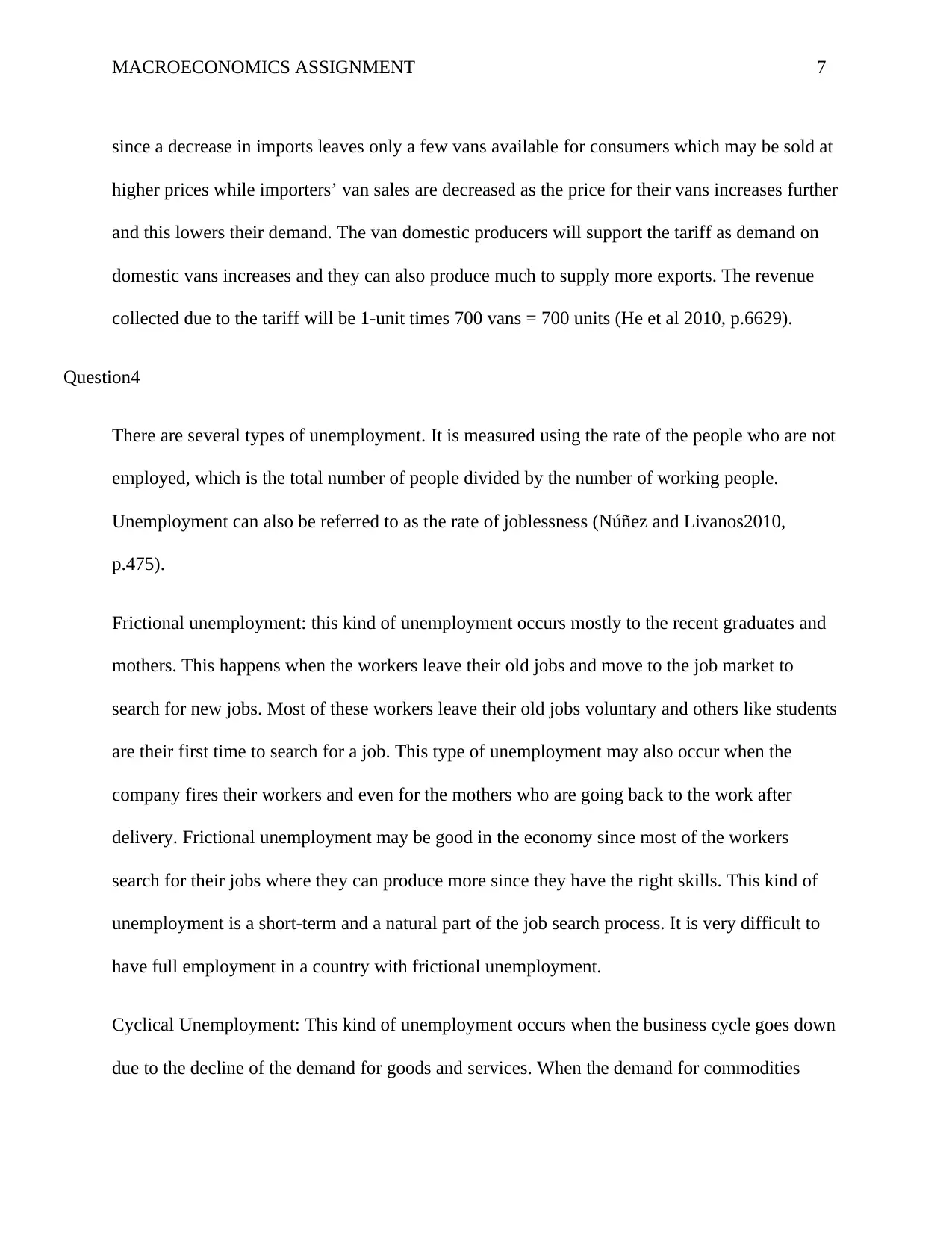
MACROECONOMICS ASSIGNMENT 7
since a decrease in imports leaves only a few vans available for consumers which may be sold at
higher prices while importers’ van sales are decreased as the price for their vans increases further
and this lowers their demand. The van domestic producers will support the tariff as demand on
domestic vans increases and they can also produce much to supply more exports. The revenue
collected due to the tariff will be 1-unit times 700 vans = 700 units (He et al 2010, p.6629).
Question4
There are several types of unemployment. It is measured using the rate of the people who are not
employed, which is the total number of people divided by the number of working people.
Unemployment can also be referred to as the rate of joblessness (Núñez and Livanos2010,
p.475).
Frictional unemployment: this kind of unemployment occurs mostly to the recent graduates and
mothers. This happens when the workers leave their old jobs and move to the job market to
search for new jobs. Most of these workers leave their old jobs voluntary and others like students
are their first time to search for a job. This type of unemployment may also occur when the
company fires their workers and even for the mothers who are going back to the work after
delivery. Frictional unemployment may be good in the economy since most of the workers
search for their jobs where they can produce more since they have the right skills. This kind of
unemployment is a short-term and a natural part of the job search process. It is very difficult to
have full employment in a country with frictional unemployment.
Cyclical Unemployment: This kind of unemployment occurs when the business cycle goes down
due to the decline of the demand for goods and services. When the demand for commodities
since a decrease in imports leaves only a few vans available for consumers which may be sold at
higher prices while importers’ van sales are decreased as the price for their vans increases further
and this lowers their demand. The van domestic producers will support the tariff as demand on
domestic vans increases and they can also produce much to supply more exports. The revenue
collected due to the tariff will be 1-unit times 700 vans = 700 units (He et al 2010, p.6629).
Question4
There are several types of unemployment. It is measured using the rate of the people who are not
employed, which is the total number of people divided by the number of working people.
Unemployment can also be referred to as the rate of joblessness (Núñez and Livanos2010,
p.475).
Frictional unemployment: this kind of unemployment occurs mostly to the recent graduates and
mothers. This happens when the workers leave their old jobs and move to the job market to
search for new jobs. Most of these workers leave their old jobs voluntary and others like students
are their first time to search for a job. This type of unemployment may also occur when the
company fires their workers and even for the mothers who are going back to the work after
delivery. Frictional unemployment may be good in the economy since most of the workers
search for their jobs where they can produce more since they have the right skills. This kind of
unemployment is a short-term and a natural part of the job search process. It is very difficult to
have full employment in a country with frictional unemployment.
Cyclical Unemployment: This kind of unemployment occurs when the business cycle goes down
due to the decline of the demand for goods and services. When the demand for commodities
Paraphrase This Document
Need a fresh take? Get an instant paraphrase of this document with our AI Paraphraser
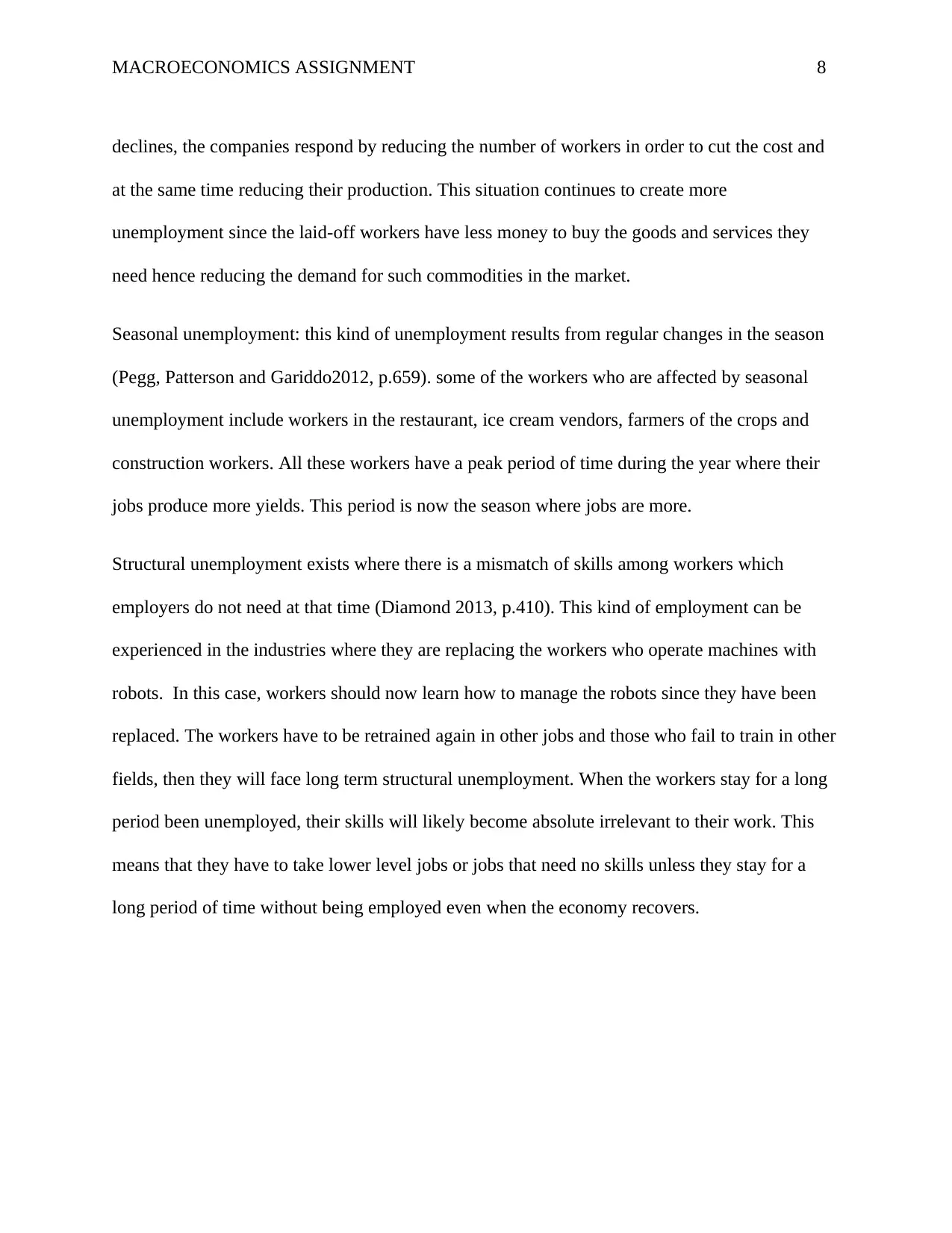
MACROECONOMICS ASSIGNMENT 8
declines, the companies respond by reducing the number of workers in order to cut the cost and
at the same time reducing their production. This situation continues to create more
unemployment since the laid-off workers have less money to buy the goods and services they
need hence reducing the demand for such commodities in the market.
Seasonal unemployment: this kind of unemployment results from regular changes in the season
(Pegg, Patterson and Gariddo2012, p.659). some of the workers who are affected by seasonal
unemployment include workers in the restaurant, ice cream vendors, farmers of the crops and
construction workers. All these workers have a peak period of time during the year where their
jobs produce more yields. This period is now the season where jobs are more.
Structural unemployment exists where there is a mismatch of skills among workers which
employers do not need at that time (Diamond 2013, p.410). This kind of employment can be
experienced in the industries where they are replacing the workers who operate machines with
robots. In this case, workers should now learn how to manage the robots since they have been
replaced. The workers have to be retrained again in other jobs and those who fail to train in other
fields, then they will face long term structural unemployment. When the workers stay for a long
period been unemployed, their skills will likely become absolute irrelevant to their work. This
means that they have to take lower level jobs or jobs that need no skills unless they stay for a
long period of time without being employed even when the economy recovers.
declines, the companies respond by reducing the number of workers in order to cut the cost and
at the same time reducing their production. This situation continues to create more
unemployment since the laid-off workers have less money to buy the goods and services they
need hence reducing the demand for such commodities in the market.
Seasonal unemployment: this kind of unemployment results from regular changes in the season
(Pegg, Patterson and Gariddo2012, p.659). some of the workers who are affected by seasonal
unemployment include workers in the restaurant, ice cream vendors, farmers of the crops and
construction workers. All these workers have a peak period of time during the year where their
jobs produce more yields. This period is now the season where jobs are more.
Structural unemployment exists where there is a mismatch of skills among workers which
employers do not need at that time (Diamond 2013, p.410). This kind of employment can be
experienced in the industries where they are replacing the workers who operate machines with
robots. In this case, workers should now learn how to manage the robots since they have been
replaced. The workers have to be retrained again in other jobs and those who fail to train in other
fields, then they will face long term structural unemployment. When the workers stay for a long
period been unemployed, their skills will likely become absolute irrelevant to their work. This
means that they have to take lower level jobs or jobs that need no skills unless they stay for a
long period of time without being employed even when the economy recovers.
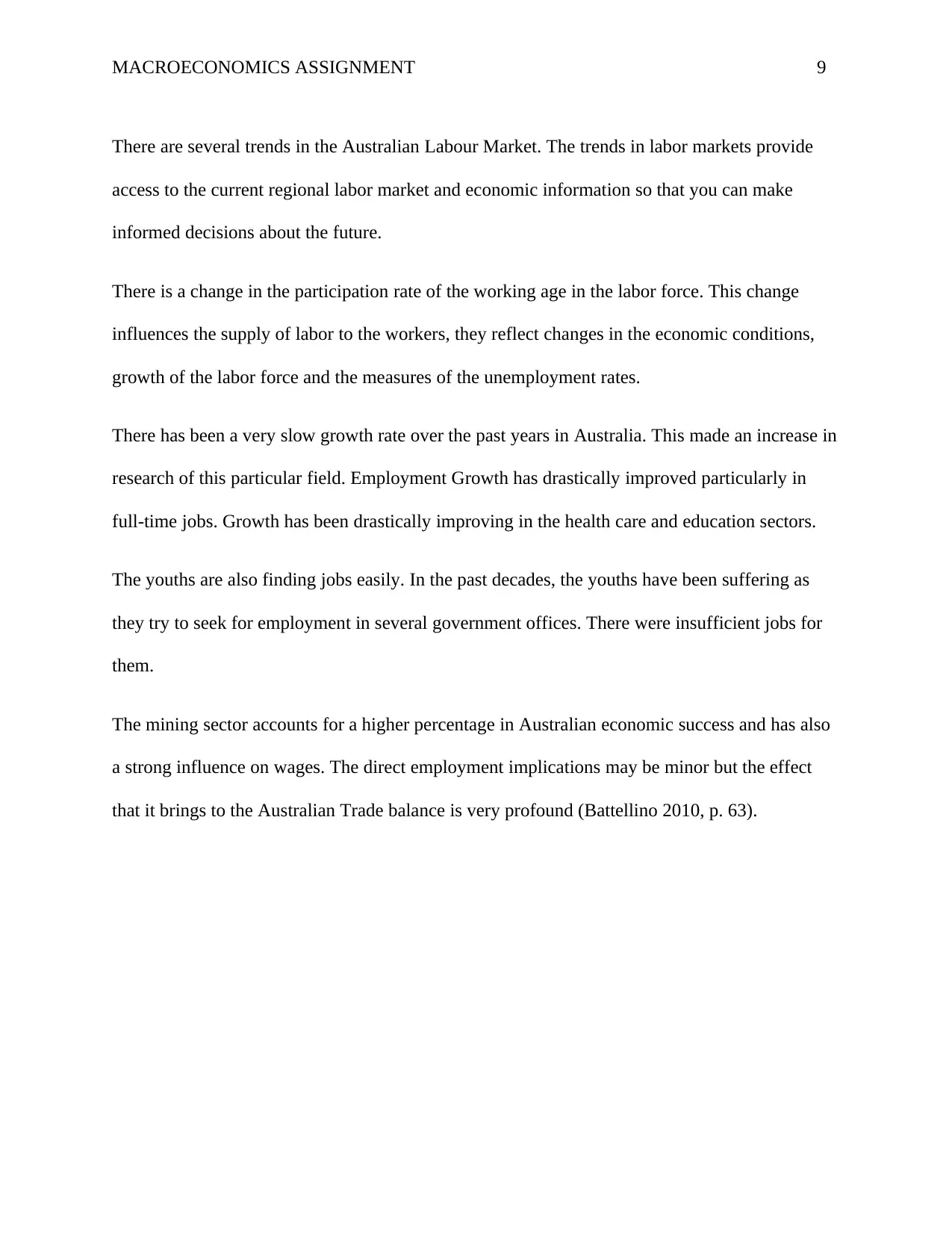
MACROECONOMICS ASSIGNMENT 9
There are several trends in the Australian Labour Market. The trends in labor markets provide
access to the current regional labor market and economic information so that you can make
informed decisions about the future.
There is a change in the participation rate of the working age in the labor force. This change
influences the supply of labor to the workers, they reflect changes in the economic conditions,
growth of the labor force and the measures of the unemployment rates.
There has been a very slow growth rate over the past years in Australia. This made an increase in
research of this particular field. Employment Growth has drastically improved particularly in
full-time jobs. Growth has been drastically improving in the health care and education sectors.
The youths are also finding jobs easily. In the past decades, the youths have been suffering as
they try to seek for employment in several government offices. There were insufficient jobs for
them.
The mining sector accounts for a higher percentage in Australian economic success and has also
a strong influence on wages. The direct employment implications may be minor but the effect
that it brings to the Australian Trade balance is very profound (Battellino 2010, p. 63).
There are several trends in the Australian Labour Market. The trends in labor markets provide
access to the current regional labor market and economic information so that you can make
informed decisions about the future.
There is a change in the participation rate of the working age in the labor force. This change
influences the supply of labor to the workers, they reflect changes in the economic conditions,
growth of the labor force and the measures of the unemployment rates.
There has been a very slow growth rate over the past years in Australia. This made an increase in
research of this particular field. Employment Growth has drastically improved particularly in
full-time jobs. Growth has been drastically improving in the health care and education sectors.
The youths are also finding jobs easily. In the past decades, the youths have been suffering as
they try to seek for employment in several government offices. There were insufficient jobs for
them.
The mining sector accounts for a higher percentage in Australian economic success and has also
a strong influence on wages. The direct employment implications may be minor but the effect
that it brings to the Australian Trade balance is very profound (Battellino 2010, p. 63).
⊘ This is a preview!⊘
Do you want full access?
Subscribe today to unlock all pages.

Trusted by 1+ million students worldwide

MACROECONOMICS ASSIGNMENT 10
References
Assous, M. and Lampa, R., 2014. Lange's 1938 model: dynamics and the “optimum propensity
to consume”. The European Journal of the History of Economic Thought, 21(5), pp.871-898.
Battellino, R., 2010. Mining booms and the Australian economy. RBA Bulletin, March, pp.63-69.
Diamond, P., 2013. Cyclical unemployment, structural unemployment. IMF Economic Review,
61(3), pp.410-455.
Farmer, R.E., 2012. The stock market crash of 2008 caused the Great Recession: Theory and
evidence. Journal of Economic Dynamics and Control, 36(5), pp.693-707.
He, Y.X., Zhang, S.L., Yang, L.Y., Wang, Y.J. and Wang, J., 2010. Economic analysis of coal
price–electricity price adjustment in China based on the CGE model. Energy Policy, 38(11),
pp.6629-6637.
Núñez, I. and Livanos, I., 2010. Higher education and unemployment in Europe: an analysis of
the academic subject and national effects. Higher Education, 59(4), pp.475-487.
Van Hoan, M., and Mai, L.C., 2016, December. Pattern Discovery in the Financial Time Series
Based on Local Trend. In International Conference on Advances in Information and
Communication Technology (pp. 442-451). Springer, Cham.
Peersman, G. and Van Robays, I., 2012. Cross-country differences in the effects of oil shocks.
Energy Economics, 34(5), pp.1532-1547.
Pegg, S., Patterson, I. and Gariddo, P.V., 2012. The impact of seasonality on tourism and
hospitality operations in the alpine region of New South Wales, Australia. International Journal
of Hospitality Management, 31(3), pp.659-666.
References
Assous, M. and Lampa, R., 2014. Lange's 1938 model: dynamics and the “optimum propensity
to consume”. The European Journal of the History of Economic Thought, 21(5), pp.871-898.
Battellino, R., 2010. Mining booms and the Australian economy. RBA Bulletin, March, pp.63-69.
Diamond, P., 2013. Cyclical unemployment, structural unemployment. IMF Economic Review,
61(3), pp.410-455.
Farmer, R.E., 2012. The stock market crash of 2008 caused the Great Recession: Theory and
evidence. Journal of Economic Dynamics and Control, 36(5), pp.693-707.
He, Y.X., Zhang, S.L., Yang, L.Y., Wang, Y.J. and Wang, J., 2010. Economic analysis of coal
price–electricity price adjustment in China based on the CGE model. Energy Policy, 38(11),
pp.6629-6637.
Núñez, I. and Livanos, I., 2010. Higher education and unemployment in Europe: an analysis of
the academic subject and national effects. Higher Education, 59(4), pp.475-487.
Van Hoan, M., and Mai, L.C., 2016, December. Pattern Discovery in the Financial Time Series
Based on Local Trend. In International Conference on Advances in Information and
Communication Technology (pp. 442-451). Springer, Cham.
Peersman, G. and Van Robays, I., 2012. Cross-country differences in the effects of oil shocks.
Energy Economics, 34(5), pp.1532-1547.
Pegg, S., Patterson, I. and Gariddo, P.V., 2012. The impact of seasonality on tourism and
hospitality operations in the alpine region of New South Wales, Australia. International Journal
of Hospitality Management, 31(3), pp.659-666.
Paraphrase This Document
Need a fresh take? Get an instant paraphrase of this document with our AI Paraphraser
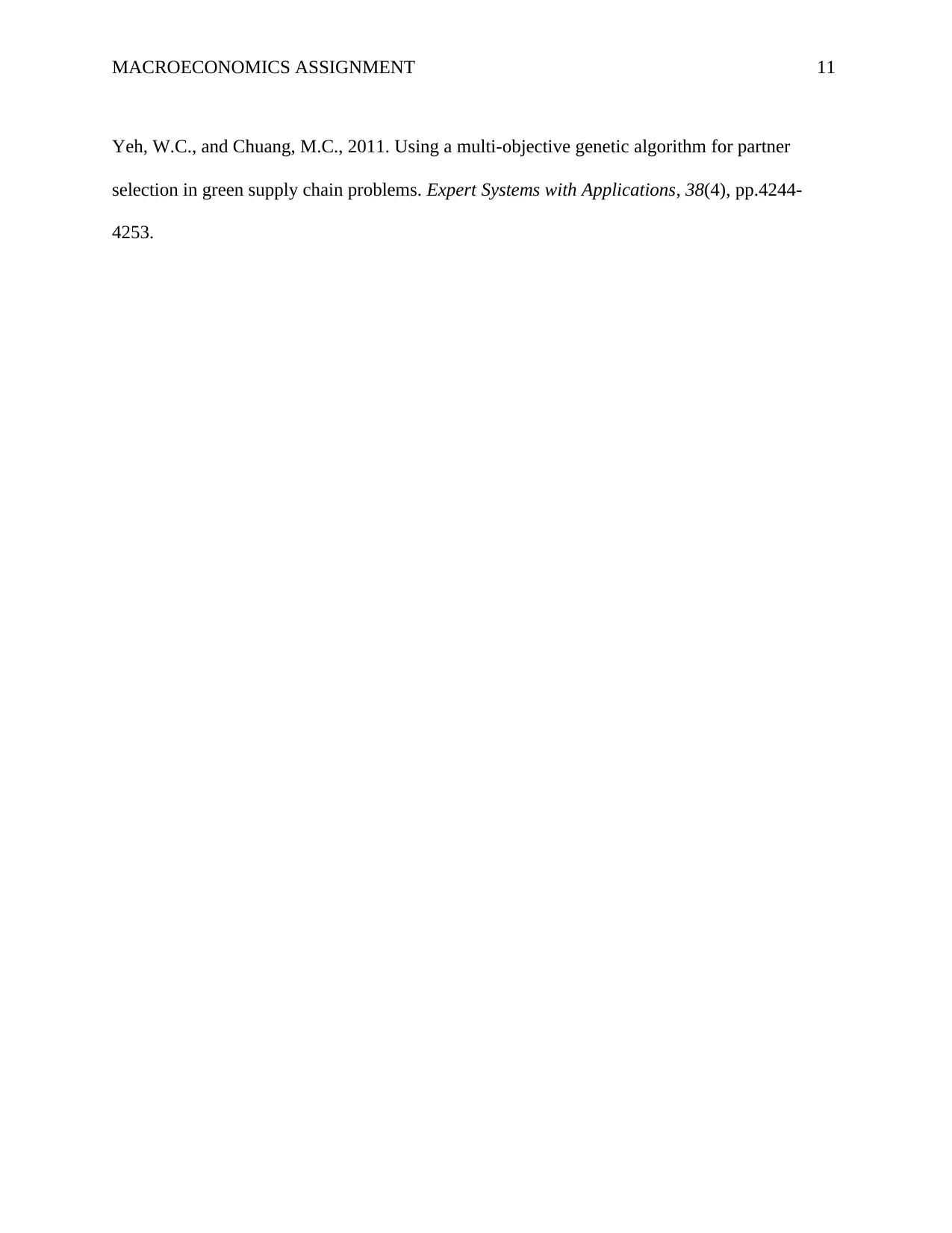
MACROECONOMICS ASSIGNMENT 11
Yeh, W.C., and Chuang, M.C., 2011. Using a multi-objective genetic algorithm for partner
selection in green supply chain problems. Expert Systems with Applications, 38(4), pp.4244-
4253.
Yeh, W.C., and Chuang, M.C., 2011. Using a multi-objective genetic algorithm for partner
selection in green supply chain problems. Expert Systems with Applications, 38(4), pp.4244-
4253.
1 out of 11
Related Documents
Your All-in-One AI-Powered Toolkit for Academic Success.
+13062052269
info@desklib.com
Available 24*7 on WhatsApp / Email
![[object Object]](/_next/static/media/star-bottom.7253800d.svg)
Unlock your academic potential
Copyright © 2020–2025 A2Z Services. All Rights Reserved. Developed and managed by ZUCOL.





